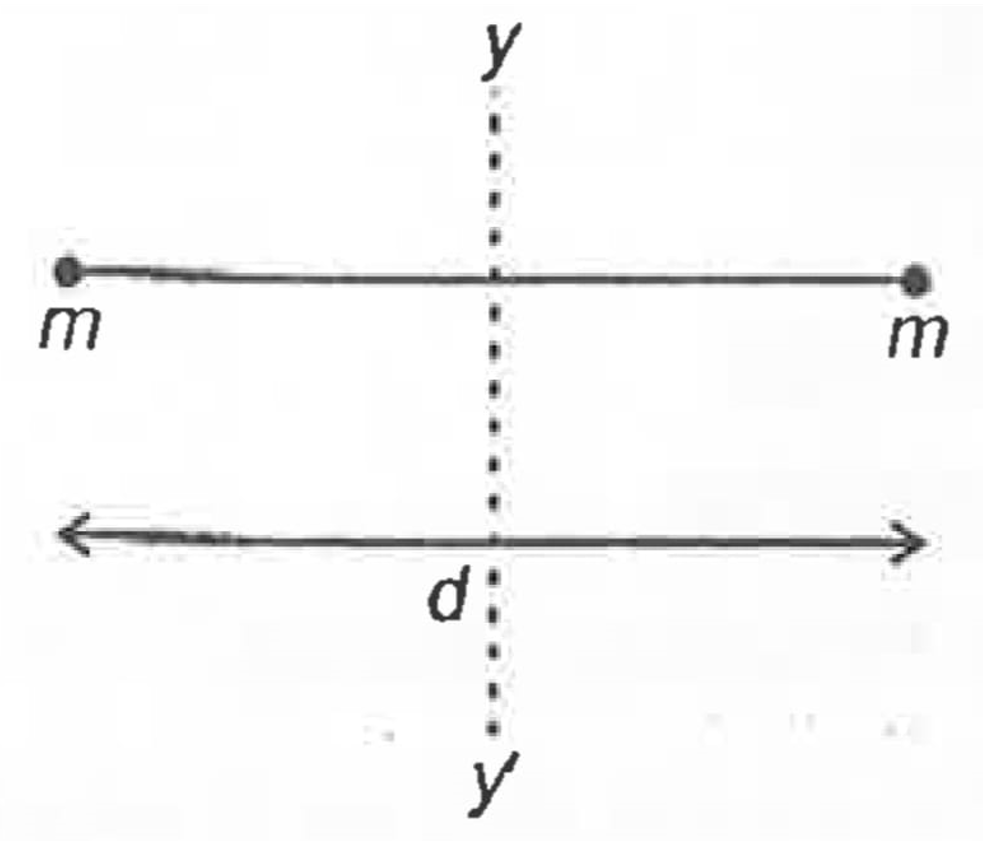Separation of Motion of a system of particles into motion of the centre of mass and motion about the centre of mass :
Show dL'dt=∑r'i×dp'dt
Further. Show that dL'dt=τ'ext
Where τ'ext is the sum of all external torques acting on the system about the centre of mass.
Use the definition of centre of mass and Newton.s Third Law. Assume the internal forces between any two particles act along the line joining the particles.)
→L=→L.+→R×M→V
d→Ldt=ddt−→L.+ddt[→R×M→V]
τexternal=d−→L.dt+→V×M→V
But →V×M→V=0
∴τexternal=d−→L.dt
Similar Questions
Separation of Motion of a system of particles into motion of the centre of mass and motion about the centre of mass :
(a) Show P=Pi+miV
where pi is the momentum of the ith particle (of mass mi) and pi=mivt Notevi is the velocity of the ith particle relative to the centre of mass.
Also, prove using the definition of the centre of mass ∑pt=0
(b) Show K=K'+1/2MV2
where K is the total kinetic energy of the system of particles. K' is the total kinetic energy of the system when the particle velocities are taken with respect to the centre of mass and MV2/2 is the kinetic energy of the translation of the system as a whole (i.e. of the centre of mass motion of the system). The result has been used in Sec. 7.14.
(c ) Show L=L'+R×MV
where L'=∑r't×p't is the angular momentum of the system about the centre of mass with velocities taken relative to the centre of mass. Remember r'i=ri−R, rest of the notation is the standard notation used in the chapter. Note L' and MR×V can be said to be angular momenta, respectively, about and of the centre of mass of the system of particles.
(d) Show dL'dt=∑r'i×dp'dt
Further, show that
dL'dt=τ'ext
where τext is the sum of all external torques acting on the system about the centre of mass.
(Hint : Use the definition of centre of mass and third law of motion. Assume the internal forces between any two particles act along the line joining the particles.)
View SolutionSeparation of motion of a system of particles into motion of the centre of mass and motion about the centre of mass:
(a)n Show →p=→pi+mi→V where →pi is the momentum of the ith particle (of mass mi) and →pi=mi→vi, Not →vi is the velocity of the ith particle relative to the centre ofmass.
Also, prove using the definition of the centre of mass ∑→pi=0
(b) Show K=K'+1/2MV2 where K is the total kinetic energy of the system of particles, K is the total kinetic energy of the system when the particle velocities are taken with respect to the centre of mass and MV2/2 is the kinetic energy of the translation of the system as a whole (i.e. of the centre of mass motion of the system)
(c) Show →L=→L+→R×MV
where →L'=∑→ri×→pi is the angular momentum of the system about the centre of mass with velocities taken relative to the centre of mass. Remember →ri=→ri−→R, reat of the notation is the standard notation used in the chapter. Note →L'andM→R×→V can be said to be angular momenta, respectively, about and of the centre of mass of the system of particles.
(d) Show d→Ldt=∑→ri×d→p'dt Further show that d→L'dt=→τext' where Text is the sum of all external torques acting on the system about the centre of mass. (Hint: Use the definition of centre of mass and Newton's Third Law. Assume the internal forces between any two particles aet along the line joining the particles.)
View Solution
Knowledge Check
The sum of moments of masses of all the particle in a system about the centre of mass is always
AzeroBmaximumCinfiniteDminimumThe rate of change of angular momentum of a system of particles about the centre of mass is equal to the sum of external torque about the centre of mass when the centre of mass is :
AFixed with respect to an inertial frame.Bin linear acceleration.Cin rotational motion.Dis in a translational motion.Choose the correct statement about the centre of mass (CM) of a system of two particles
AThe CM lies on the line joining the two particles midway between themBThe CM lies on the line joining them at a point whose distance form each particle is inversely proportional to the mass of that particleCThe CM lies on the line joining them at a point whose distance from each particle is proportional to the square of the mass of that particleDThe CM is on the line joining them at a point whose distance from each particle is proportional to the mass of that particle
The rate of change of angular momentum of a system of particles about the centre of mass is equal to the sum of external torque about the centre of mass when the centre of mass is :
View Solutionfind moment of inertia about an axis yy which passes through the centre of mass of the two particle system as shown

View Solutionfind moment of inertia about an axis yy which passes through the centre of mass of the two particle system as shown

View SolutionThe motion of the centre of mass of a system of two particles is unaffected by their internal forces.
View SolutionTwo bodies of masses 1 kg and 2 kg, separated by 6 m are rotating about the centre of mass of the system. The moment of inertia of the system is
View Solution
